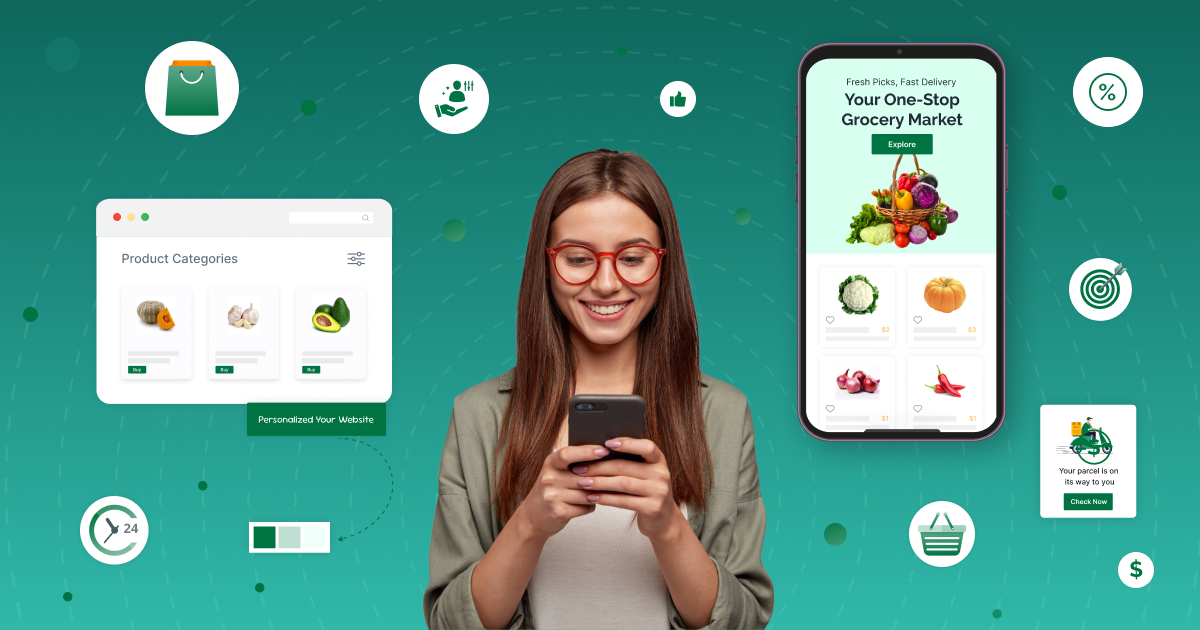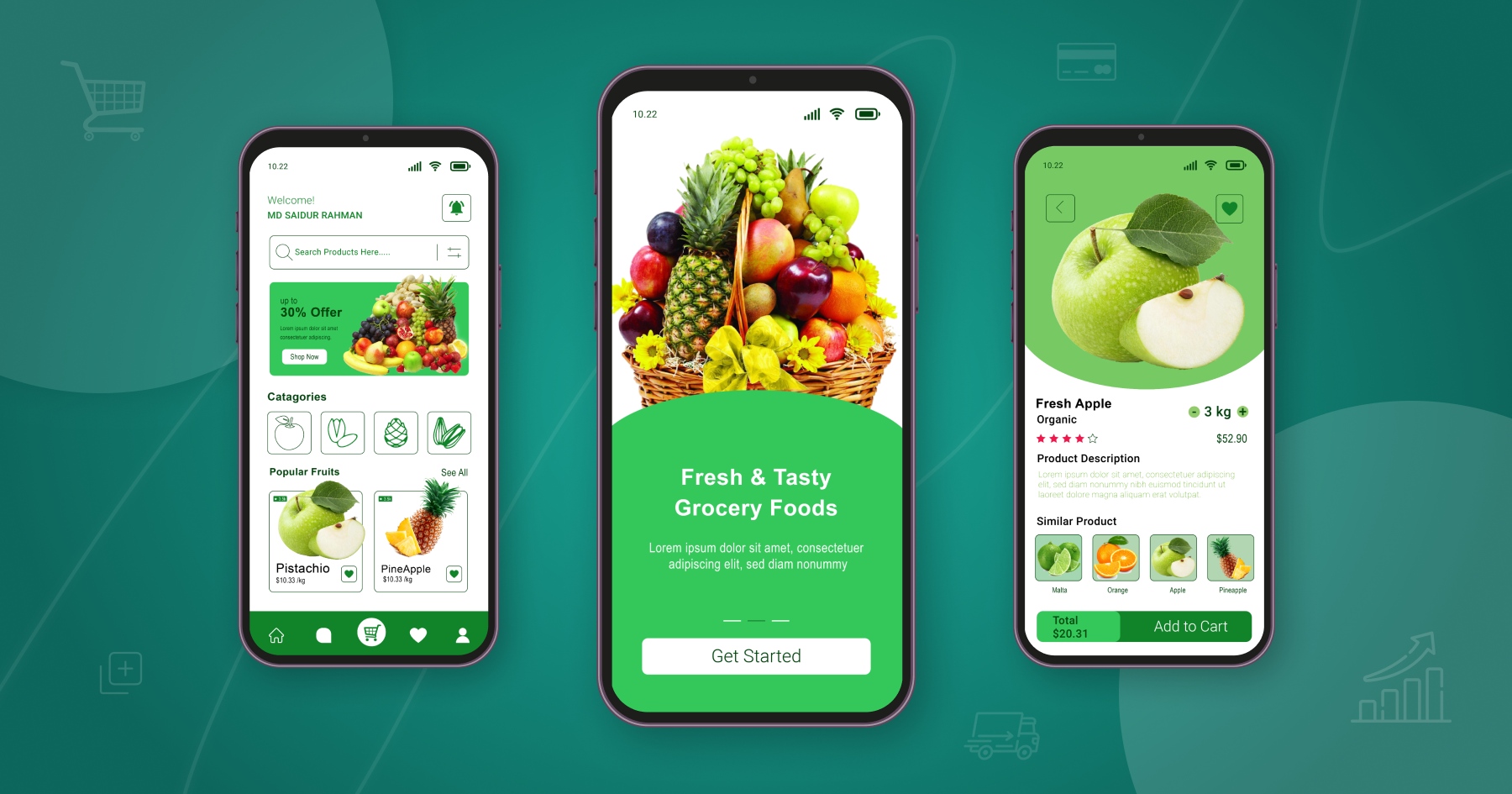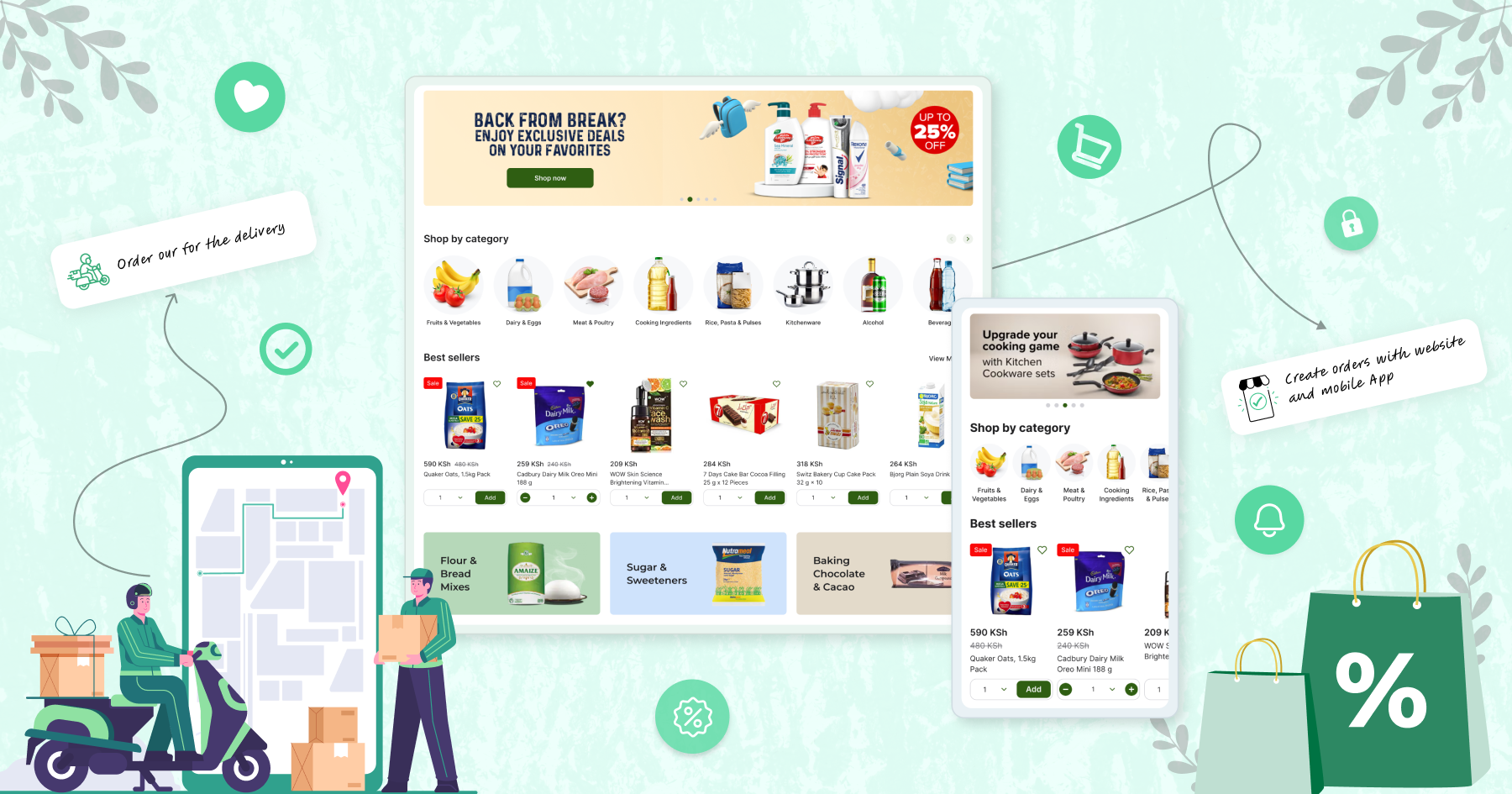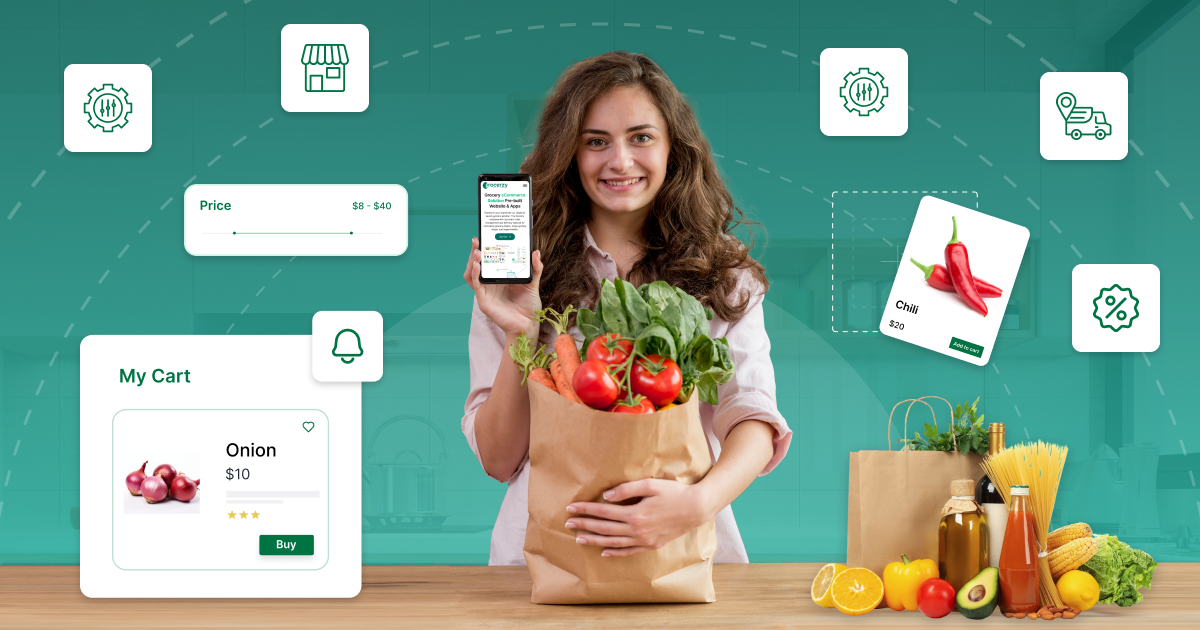How to Build a Grocery eCommerce App for Retail Business?

The retail business of groceries has never experienced such a digital transformation. As customers grow more techno-friendly and reliant on mobile technology, the mobile shopping trend has left aisles behind and made apps the preferred tool. Online grocery store will make life easier for busy professionals who struggle to find time to shop and prefer having their groceries delivered right to their door.
To the retail business the change has provided colossal opportunities but also new challenges. In order to continue working in such a setting, a dedicated grocery eCommerce app is not a luxury anymore but a necessity.
A mobile application allows retailers to provide convenience, broaden the market, and simplify processes, and consequently to be able to better serve the modern customers.
The Need for a Grocery eCommerce App for Retail Businesses
- Accessibility- Physical accessibility and location have been the backbone of traditional retail, but the current consumer is keen on digital convenience now more than ever. A grocery eCommerce application like Grocerzy will help a single retailer to address these expectations fully.
1This kind of an app enables the businesses to access the customers far beyond their respective areas so geographical boundaries are broken without the need to establish any physical store. To small and medium-sized retailers, this amount of scalability is a cost-effective method of expanding.
- Interaction level- The other essential advantage is customer interactions. In a brick and mortar store, the relationship stops at the checkout counter, whereas in an app, it will go on.
Trust and confidence in the company will also have customers using these to keep coming back by way of push notifications, loyalty programs, personal deals and subscriptions. It is also possible that retailers could utilize the app to focus on a better brand recognition which turns into a more difficult issue when operations happen offline.
- Data creation- In addition to that, a grocery app creates priceless data. With the help of purchase trends, browsing behavior, and order frequency, retailers can ensure a grain development in the inventory and lessen wastages and forecast demands.
An example here is where information can show that there is an increasing demand for organic produce in particular places, the retailer will be able to stock more. The understanding will result in wiser choices being made to enhance profitability.
- Competitiveness- Last but not the least, the necessity to be competitive is the most urgent one. There are already giants that control the online grocery market. Customers who get used to the convenience of placing an online order of the goods they need are not likely to go back to traditional shopping.
Local retailers are in danger of losing their share of the market without a grocery app solution. Groceries that invest in the development of mobile apps for groceries respond to the needs of the future and stay in the fast-paced business environment.
Important Business Models for Online Grocery Shopping
Selecting an appropriate business model is the basis of starting an effective grocery eCommerce app. There are various methods available to the retailers with different formats of the solutions paying attention to the needs and capabilities of each.
- Single-store model- It is suitable in the case of supermarkets or independent grocers who prefer to take their business digital. In this model, the app itself is the store itself and customers can look at the store inventory and make orders and it can be delivered to the customers by the same store. It is a simple method that enhances the connection between the store and the customers that are loyal.
- Multi-vendor model- The concept is further developed in the multi-vendor marketplace model where several retailers and suppliers can post their products in one platform. In this case, the app will become a mediator, which will allow consumers to have a handful of stores and brands in a single location. The model provides more choice and diversity, and is desirable to those customers that like choice.
- Inventory model- An inventory model demands the retailer to own their warehouses and do the deliveries themselves. Inasmuch as this increases costs and logistics, it provides businesses with absolute control on quality of their products, inventory, and customer support. In the case of a bigger retailer, the model is more consistent and has greater brand authority.
- Subscription model- Groceries made by subscription are also becoming more popular. This type of model is effective in the case of such basic products as milk, bread, and vegetables; people have set schedules and they want these supplies to be delivered accordingly. Retailers can have consistent revenue and alleviate customer churn by offering weekly or monthly subscriptions.
- Hyperlocal delivery model- Lastly, the one that deserves to be mentioned in the list is the hyperlocal delivery model wherein the app introduces customers to local shops where quick deliveries will be made within the limits of the certain geographic region. The model is appropriate in small cities and companies interested in ensuring ultra-fast delivery and supporting the suppliers in their areas.
The Key Features of an eCommerce App for Grocery
- Support- An effective grocery application is developed based on functions that support customers, administrators, and delivery agents. Customers also demand immediate, smooth experience to match that of in-store shopping with retailers needing effective management tools.
- Convenience- On the customer-side, with other features such as simple registration, intelligent search of product, and structured category, navigation is simple. Convenience is increased by a basic shopping cart, safe payments, and tracking.
- Loyalty program- The creation of the loyalty program, the use of discounts and personal recommendations help to generate engagement, and the use of push notifications helps customers stay informed about offers and promotions. Customers also use ratings and reviews to make their choice and build trust in the platform.
- Admin panel- In the case of the admin panel, control and oversight is important. To manage products, track inventory, and handle delivery operations, a grocery app must offer the tools. Analytical dashboards can assist in monitoring sales performance, customer preference, and revenue trends. Also, built-in support services mean the company can promptly reply to the comments or complaints and keep customer satisfaction.
- Operation dashboard- In the case of delivery agents, the app must streamline their operations. The job becomes easier and sustaining with timely deliveries because of the profiles, schedules, optimized routes, and earnings dashboards. As customer satisfaction is frequently judged by the quality of their delivery, it is important to provide agents with the correct equipment.
All these capabilities in Grocerzy application guarantee that it is not merely a digital storefront but a full ecosystem uniting customers, businesses, and delivery personnel.
Tech Stack for Developing Mobile Apps for Grocery
- A well-selected technology stack is behind every well-balanced user experience. Frameworks such as React Native or Flutter used to create cross-platform apps should be used in building the frontend of a grocery mobile app that runs on iOS and Android. Swift to iOS and Kotlin to Android are the preferred platforms in the event that one wishes to have platform-specific performance.
- It is also important to note the importance of the backend because it runs the orders, payments, and data. Other highly popular technologies such as Node.js, Django, or Ruby on Rails come with a lot of scalability and strength. To store data, databases like MongoDB, MySQL or PostgreSQL are the ones that do not fail in managing large product lines and customer details.
- Integrations of the third parties are also significant. Payments, such as Stripe, Razorpay and PayPal bring about secure payment gateways. The APIs at Google Maps allow tracking delivery in real-time. Firebase Cloud messaging and Push notifications keep the customers hanging on. Lastly, cloud hosting platforms, like AWS, Google Cloud, or Microsoft Azure, will allow the necessary scalability to support increasing usage traffic.
- The high tech stack can also be used to maintain the reliability of the system but also add to the longevity of the app by providing an opportunity to update or add new offerings on a separate basis.
Pathway to an eCommerce App for Grocery
- A grocery eCommerce application is a planned process that includes research and concludes with implementation.
- The process begins with market research and planning, during which companies compare competitors, research the attitudes of customers, and determine their target markets. This step also entails the appropriate selection of business models, either the single store, marketplace, or subscription based.
- The second one is to choose the development strategy. Retailers have the option of custom development which is the most flexible but also consumes more time and capital. As an alternative, they may pursue a ready made grocery application, or a white label grocery delivery application, which is less time-consuming and less expensive.
- After selecting the approach, UX design commences. This phase is devoted to designing the intuitive interface that will enhance ease in navigation, easy product discovery and ease in checkout.
- This is followed by the backend development and API integration so that the app is capable of dealing with orders, inventory, and payments safely. Once developed, intense testing is carried out to find and fix bugs in order to have the app run perfectly across machines.
- Lastly, the application is released to the Google Play Store and iTapp App Store and a grocery eCommerce website is launched on desktop users. Marketing Continuous are post-launch, such as referral and first-order discounts making sure that users adopt them well.
Advantages of White Label and Ready-Made Grocery App Solutions
Ready made grocery apps and white label grocery delivery apps serve as a viable option to retailers keen to join the digital space or fast. These ready-to-use platforms have the key features included and could be personalized based on the provider of treatment (a retailer) with its branding, merchandise and monetary access chances.
The advantages are evident, shorter time of development, cheaper, and faster access to the market. Retailers no longer have to deal with technicalities, but instead put effort on operations and customer outreach. Besides, such solutions are based on the frameworks that have been tested; hence, the risks in terms of bugs or performance problems will be lowered.
These apps can also have add-on features implemented when extra features are required by the businesses that plan to scale at later times.
A white label app means that retailers obtain a turnkey product at a small fraction of the price, which looks and feels like a custom product.
Challenges in Developing Grocery Delivery Apps
Although the opportunities are desirable, grocery delivery app solution have challenges when building and managing them. One of the largest challenges is logistics, the process of delivery of perishable items in time, avoiding financial effects without effective planning is challenging. Another problem is inventory control where customers might get frustrated with any instances of stock outages or out-of-date listing.
Competition is also fierce. The space is dominated by established players and local retailers require powerful strategies to be able to stand out. Retaining customers is also not an easy task, because shoppers usually turn over to other competitors with superior offers.
And lastly, technology should be constantly updated, through security patches and improvements, to ensure the app is always relevant and reliable.
Conclusion
The emergence of online trade has demonstrated that the online world is something that retail companies should not overlook. A grocery ecommerce solution is not only a technological investment since it is also a strategic step that defines the future of any industry.
The combination of the appropriate business model, adding the necessary characteristics, and utilizing technology to the full extent has allowed retailers to design apps that are not only engaging in standing against international giants; they can also produce strong loyal customer groups.
With the increasing online grocery shopping demands, the individuals who adopt digital solutions at the current are the ones who will define the future of retail tomorrow.



